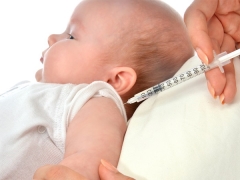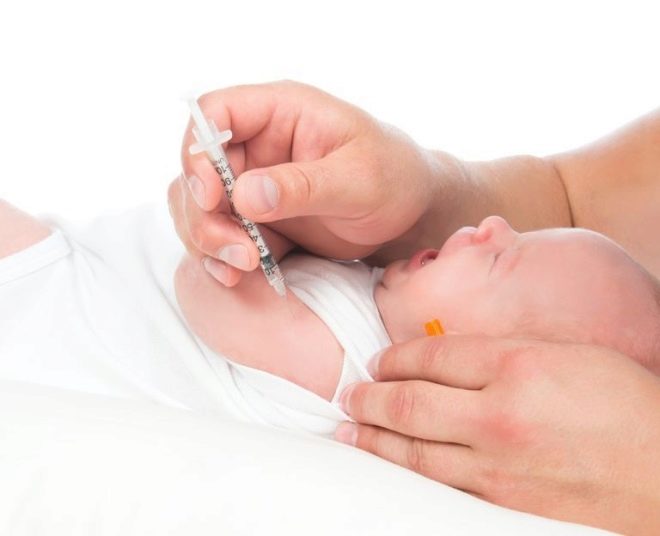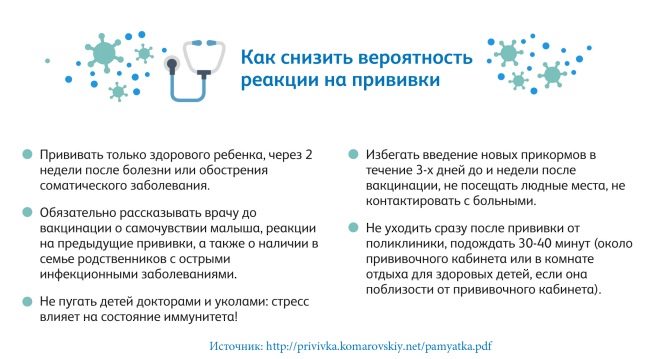BCG vaccination against tuberculosis
The BCG vaccine is the second vaccine that the baby meets after birth, is BCG. Therefore, learning about BCG is worth more to all parents.
What is vaccinated from?
This vaccine is aimed at a disease like tuberculosis. Due to the high prevalence of this disease and the constant contact of people with mycobacteria, BCG is placed on all newborns, as it is in childhood that there is a high risk of developing severe forms of tuberculosis.
The disease is classified as social, as it develops under the action on the body of such factors as unfavorable living conditions, poor sanitary conditions, the presence of bad habits, malnutrition and the like. Most often, tuberculosis occurs in the lung tissue, causing a cough, but mycobacteria can spread almost throughout the body, which is life threatening.
pros
- The introduction of BCG will help reduce the risks of developing a primary form of tuberculosis infection, as well as life-threatening severe forms of the disease.
- The vaccine has been used for decades, so its effect on newborns has been well studied.
- With an adequate examination of the child, the vaccination of newborns is easily tolerated.
- There is a sparing version of the vaccine (BCD-M) with half the concentration of mycobacteria, which is administered to weakened children.
Minuses
- The vaccine does not protect against infection with tubercle bacilli.
- Due to its introduction, post-vaccination complications may occur.
Contraindications
The vaccine is not administered in such cases:
- A newborn weighs less than 2.5 kg (with a weight ranging from 2 kg to 2.5 kg, administration of BCG-M is indicated).
- The child has an acute illness or a chronic illness has become exacerbated. Vaccination is not carried out with intrauterine infection, neurological problems, hemolytic disease and other acute pathologies.
- The baby has immunodeficiency.
- Close relatives of the child had a generalized infection.
- The mother of the child has been diagnosed with HIV.
- The child has a tumor.
- Mantoux test gave a positive or dubious result.
- A keloid scar appeared at the site of BCG injection, or lymphadenitis developed as a result of the first vaccine injection.
Possible complications
First of all, all parents need to learn that the reaction to vaccination against tuberculosis in the form of a pust does not belong to complications. It is extremely rare after vaccination can develop:
- Cold abscess - appears if the drug gets under the skin, requires treatment from a surgeon.
- The formation of an ulcer at the injection site with a diameter of more than 1 cm indicates that the child is more sensitive to the drug and is treated topically.
- Lymphadenitis - develops when mycobacteria get into lymph nodes, needs surgery if the lymph node is enlarged to exceed 1 cm.
- Keloid scar - the skin at the injection site becomes red and bulges, in this case, no revaccination is performed.
- Osteomyelitis - the defeat of the mycobacteria of the bones, it happens in one child out of 200 thousand vaccinated, caused by immune disorders.
- Generalized BCG infection - develops in one baby per million vaccinated, is associated with severe impaired immunity in the child.
The reasons for the occurrence of complications during BCG vaccination are often reduced immunity in a child or a poor-quality vaccine. Therefore, it is especially important to consider the presence of contraindications to immunization.
There is no special preparation for this vaccination. It is only important to make sure that there are no contraindications for immunization, which is done by a neonatologist in a maternity hospital, a pediatrician in a polyclinic, or a tuberculosis specialist in a TB clinic.
Should I vaccinate?
Many parents are alarmed by the fact that tuberculosis is still highly prevalent with a comprehensive vaccination. They need to understand that BCG is not aimed at preventing the infection with mycobacteria. However, such a vaccine with proven effectiveness weakens the course of the disease in young children.
Thanks to the introduction of BCG, cases of dissemination of the tubercle bacillus in the body, as well as tuberculous meningitis, have become rare. And since they usually end in death in children under 2 years of age, administration of BCG is justified at an early age.
Opinion E. Komarovsky
The famous pediatrician considers tuberculosis to very dangerous diseases, from which it is necessary to inoculate. He is sure that it is better to inoculate a baby with weakened bacteria than to allow the child to meet with active ones. And since such a risk is almost everywhere - from the store to the bus, vaccination is a must.
How to make an injection?
For immunization use a disposable syringe. The vaccine is injected into the skin in the left shoulder, in the place between the middle and upper third. Often, the entire dose of BCG is administered once, but there is also a technique that involves several injections at closely spaced points. The introduction of the vaccine into the muscle tissue or under the skin is unacceptable. If there is no possibility to put a vaccination in the shoulder, choose another place in which the skin is quite thick (usually the thigh).
The skin on the shoulder is tensioned and the needle is inserted, after which a small amount of vaccine is released, checking whether the needle has fallen into the skin. As a result of the introduction, a flat white papule forms on the shoulder of the child. Its diameter is up to 10 mm. After 15-20 minutes, such a papule usually disappears.
At what age do vaccination?
BCG is administered while in the hospital - most often on the third or fourth day of the child's life. The official dates for the administration of BCG in the maternity hospital are 3-7 days after birth. If contraindications are present, vaccination is performed immediately when it becomes possible.
How to heal?
The reaction to BCG develops within four to six weeks after the injection, manifesting itself in 1-1.5 months to 4.5 months. First, a discoloration of the skin may appear at the injection site — it may darken, becoming purple, blue or even black. After in place of the modified skin appears abscess. Gradually, it becomes crusted and heals, and when the crust disappears, a small scar remains at the injection site.
In some children, instead of an abscess, a reddish vial containing a liquid appears. It, too, is covered with a crust and leaves a scar after tightening. If the child has a abscess, it can break through. The discharge of pus from it and the formation of another abscess are normal variants of the reaction to BCG.
Why does the scar remain?
As a result of the development of the vaccination reaction, the characteristic scar remains. Normally, its value is from 2 to 10 mm. It is believed that a scar size greater than 5 mm is a sign of an adequate response to immunization.
If there is no trace of injection
The presence of the scar helps to determine if the child has been injected with BCG previously. If there is no such trace, the vaccine should be introduced in the near future or wait for periods of revaccination.If the child was vaccinated and the scar did not appear, this indicates the ineffectiveness of the immunization. This happens in 5-10% of children.
In addition, there is a certain percentage of people who are genetically immune to mycobacteria. They do not become infected with tuberculosis, and they do not have a reaction to BCG.
Compatibility with other vaccinations
No other vaccinations are performed at the same time as BCG. Also, you should not vaccinate the child during the development of the reaction to this vaccine. Since the introduction of BCG to other vaccinations should take at least 4-6 weeks. That is why in the maternity hospital the child is put first a vaccine against hepatitis, and then BCG.
Revaccination
In addition to the first introduction of BCG in the maternity hospital in our country, this vaccine can be put in 7 years, and then in 14 years. The reason for revaccination is a negative Mantoux test, as well as the presence of tuberculosis in people who are in contact with the child. With revaccination, the drug is also injected into the shoulder using an intradermal injection.
What if the child is not vaccinated in the hospital?
An unvaccinated child should be vaccinated as soon as his condition allows. In this case, prior to the introduction of the BPC, the Mantoux test is made and the vaccine is injected 3–14 days after the negative result of the test. If Mantu gave a positive result, it is already useless to introduce BCG. Mantoux test is not carried out, if the baby is less than 2 months old - such kidney BCG can be entered into the clinic immediately.
Vaccination can be carried out in the clinic in the vaccination room, as well as in a tuberculosis dispensary. Usually, no other vaccinations are given in the vaccination room on the day of BCG administration. It is impossible to carry out the manipulation in the usual treatment room, where blood is taken and injected. If there is an increased risk of a reaction to a vaccine, BCG is administered in a hospital. It is also legally allowed to vaccinate children at home and in specialized centers that have certificates.
What if there are side effects?
Suppuration at the site of the vaccine at the time when the reaction to the vaccine develops is the norm, but the skin around the abscess should not be swollen and red. If the injection site is swollen, red, has suppressed many times, or the edema has spread much, it is important to consult a doctor immediately.
Also, the child during the period of suppuration may increase the temperature. Often it is no higher than 37.5 degrees and is considered normal.
Tips
- The injection site should be protected from mechanical irritation - do not rub it, scratch it, and so on. While bathing it should not be touched with a washcloth.
- During the period of healing of the abscess, the wound on the shoulder cannot be smeared and powdered. If pus is released from it, you can cover the wound with a piece of clean gauze, which is often changed. Squeezing the contents of the abscess is prohibited.
Reviews
The opinions of parents about vaccination against tuberculosis are very different. Someone does not doubt the need for the introduction of BCG, and someone is frightened by possible complications and wondering whether it is worthwhile to load the immune system of a just-born child. Parents who are faced with post-vaccination complications in their children are opposed to vaccination in general. However, many parents carefully study all the information about BCG, preferring to protect their babies from tuberculosis with the help of such a vaccine and sleep well.
















